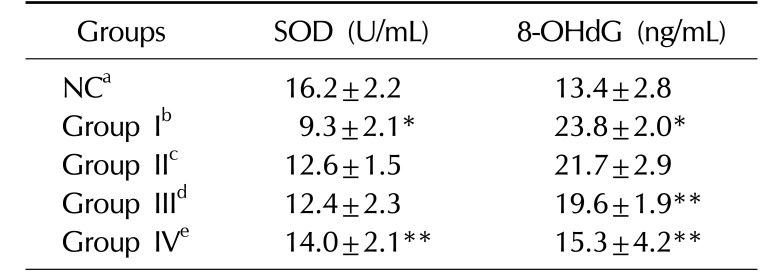INTRODUCTION
MATERIALS AND METHODS
1. Plant material and preparation of the herbal formula
Table 1
Herb profiles of Epimedium koreanum Nakai and Angelica gigas Nakai

2. Ethics statement
3. Animal groups and treatment protocol
4. Measurement of cauda epididymal sperm count and motility
5. Measurement of testosterone, free testosterone, luteinizing hormone, and follicle-stimulating hormone
6. Histological evaluation of spermatogenic cell density
7. Measurement of oxidative stress markers
8. Statistical analysis
RESULTS
1. Body and organ weight
Table 2
Effects of KH-465 on the body, testis, and epididymis weights in Sprague-Dawley rats with LHRH agonist-induced infertility

Values are presented as mean±standard deviation (of at least 3 independent experiments).
LHRH: luteinizing hormone-releasing hormone, NC: normal control.
aNormal control group, bLHRH agonist-induced infertility control group, c200 mg/kg/day of KH465 in LHRH agonist-induced infertility group, d400 mg/kg/day of KH465 in LHRH agonist-induced infertility group, e24 mg/kg/day of testosterone in LHRH agonist-induced infertility group.
2. Effects of KH-465 on sperm parameters and sex hormones
Table 3
Effects of KH-465 on testicular tissue and sex hormones in Sprague-Dawley rats with LHRH agonist-induced infertility

Values are presented as mean±standard deviation. *Versus NC group (p<0.05), **Versus LHRH-induced control group I (p<0.05).
LHRH: luteinizing hormone-releasing hormone, T: testosterone, FSH: follicle-stimulating hormone, LH: luteinizing hormone, NC: normal control.
aNormal control group, bLHRH agonist-induced infertility control group, c200 mg/kg/day of KH465 in LHRH agonist-induced infertility group, d400 mg/kg/day of KH465 in LHRH agonist-induced infertility group, e24 mg/kg/day of testosterone in LHRH agonist-induced infertility group.
3. Effect of KH-465 on testicular morphology
 | Fig. 1Histological analysis of seminiferous tubules from normal controls, luteinizing hormone-releasing hormone (LHRH)-induced infertility controls, LHRH-induced rats treated with testosterone, and LHRH-induced rats treated with 400 mg/kg of KH-465. Representative images of tubular cross-sections of the testis are shown. (A) Normal control group pretreatment, (B) normal control group after 8 weeks, (C) LHRH agonist-induced control group I after 4 weeks, (D) LHRH agonist-induced control group I after 8 weeks, (E) LHRH-induced group treated with 400 mg/kg of KH-465 (group III) after 8 weeks, and (F) LHRH-induced group treated with testosterone (group IV) after 8 weeks. All sections were stained with H&E (×400). The images are typical of those obtained in 5 independent experiments. |
4. Effects of KH-465 on oxidative stress markers
Table 4
Effects of KH-465 on SOD and 8-OHdG activity in Sprague-Dawley rats with LHRH agonist-induced infertility

| Groups | SOD (U/mL) | 8-OHdG (ng/mL) |
|---|---|---|
| NCa | 16.2±2.2 | 13.4±2.8 |
| Group Ib | 9.3±2.1* | 23.8±2.0* |
| Group IIc | 12.6±1.5 | 21.7±2.9 |
| Group IIId | 12.4±2.3 | 19.6±1.9** |
| Group IVe | 14.0±2.1** | 15.3±4.2** |
Values are presented as mean±standard deviation. *Versus NC group (p<0.05), **Versus LHRH-induced control group I (p<0.05).
SOD: superoxide dismutase, 8-OHdG: 8-hydroxy-2′-deoxyguanosine, LHRH: luteinizing hormone-releasing hormone, NC: normal control.
aNormal control group, bLHRH agonist-induced infertility control group, c200 mg/kg/day of KH465 in LHRH agonist-induced infertility group, d400 mg/kg/day of KH465 in LHRH agonist-induced infertility group, e24 mg/kg/day of testosterone in LHRH agonist-induced infertility group.




 PDF
PDF ePub
ePub Citation
Citation Print
Print



 XML Download
XML Download